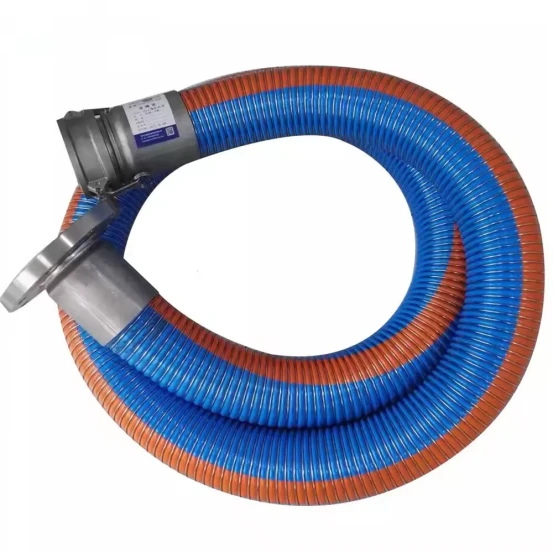Composite Hose
Composite hoses are advanced, flexible hoses designed to handle the transfer of liquids, gases, and chemicals safely and efficiently across various industries. Constructed with multiple layers, these hoses combine the benefits of different materials to provide superior strength, flexibility, and chemical resistance.
The core of a composite hose is typically made from a smooth, non-metallic inner liner that resists corrosion and chemical attack, making it suitable for transporting aggressive fluids such as acids, solvents, and fuels. Surrounding this liner are one or more layers of high-tensile synthetic yarns or fabric that provide excellent pressure resistance and structural integrity without adding excessive weight.
Unlike traditional metal hoses, composite hoses offer exceptional flexibility, allowing for easy handling, bending, and installation in confined spaces or complex piping systems. They are also lightweight, reducing strain on equipment and operators.
Composite hoses are designed to operate under a wide temperature range, often from -40°C to +100°C or higher, depending on the specific materials used. They exhibit excellent resistance to abrasion, weathering, UV radiation, and many chemicals, ensuring a long service life even in harsh environments.
These hoses are commonly used in petrochemical, chemical, pharmaceutical, and food industries for loading and unloading tanks, railcars, ships, and pipelines. Their modular construction also allows for customization in length, diameter, and fittings to meet specific application requirements.
In summary, composite hoses provide a reliable, lightweight, and flexible solution for safely transferring a wide variety of fluids, combining chemical resistance, durability, and ease of use in one high-performance product.
What Is Composite Hose?
Composite hose is a flexible, multi-layered hose designed for the safe and efficient transfer of a wide range of liquids and gases, especially in industries requiring chemical resistance and flexibility. Unlike traditional hoses made from a single material, composite hoses are constructed from several layers of different materials, combining the benefits of each to achieve superior performance.
At the core of a composite hose is a smooth inner lining made from chemically resistant materials such as thermoplastic or rubber, which prevents corrosion and contamination of the transferred fluid. Surrounding this core are multiple layers of high-strength synthetic fabrics or yarns, which provide excellent tensile strength and pressure resistance while keeping the hose lightweight.
Composite hoses are highly flexible, making them easy to handle and install even in tight spaces or complex piping systems. Their design allows them to bend without kinking, which helps maintain steady flow rates and reduces wear and tear.
These hoses are also designed to withstand a wide range of temperatures, typically from -40°C to +100°C or higher, and are resistant to abrasion, UV exposure, weathering, and many chemicals. This durability ensures a long service life in demanding environments.
Common applications for composite hoses include chemical transfer, petroleum product handling, food and beverage processing, and loading and unloading of railcars, tankers, and ships. Their versatility and strength make them a preferred choice in industries such as petrochemical, pharmaceutical, and industrial manufacturing.
In summary, composite hoses offer a combination of chemical resistance, flexibility, strength, and durability, making them ideal for transporting various fluids safely and efficiently.
Which Is Better: Composite Hose or Rubber Hose?
Choosing between a composite hose and a rubber hose depends largely on the application, environment, and specific requirements, as each has distinct advantages.
Composite Hose:
Composite hoses are made from multiple layers of synthetic materials and a smooth inner liner, offering excellent chemical resistance, flexibility, and lightweight construction. They excel in handling aggressive chemicals, fuels, and solvents, making them ideal for petrochemical, pharmaceutical, and industrial fluid transfer. Composite hoses are highly flexible and can be easily bent without kinking, which is advantageous in tight or complex installations. They also resist corrosion and have a long service life in harsh environments. However, composite hoses can be more expensive upfront and may require specialized fittings.
Rubber Hose:
Rubber hoses, made from natural or synthetic rubber, are robust and versatile. They provide excellent abrasion resistance, impact strength, and flexibility. Rubber hoses handle a wide range of temperatures and pressures, commonly used in hydraulic systems, air and water transfer, and heavy-duty industrial applications. They are generally more affordable and widely available with various reinforcement options like textile or wire braiding. However, rubber hoses may degrade faster when exposed to certain chemicals, oils, or UV radiation, and they tend to be heavier than composite hoses.
Summary:
If your application requires handling harsh chemicals, fuels, or high flexibility in tight spaces, a composite hose may be the better choice. If durability, abrasion resistance, and cost-effectiveness for general-purpose use are priorities, a rubber hose is often preferable.
Ultimately, the best choice depends on the specific fluids, pressure, temperature, and working environment. Consulting with a hose specialist can ensure the right selection.





